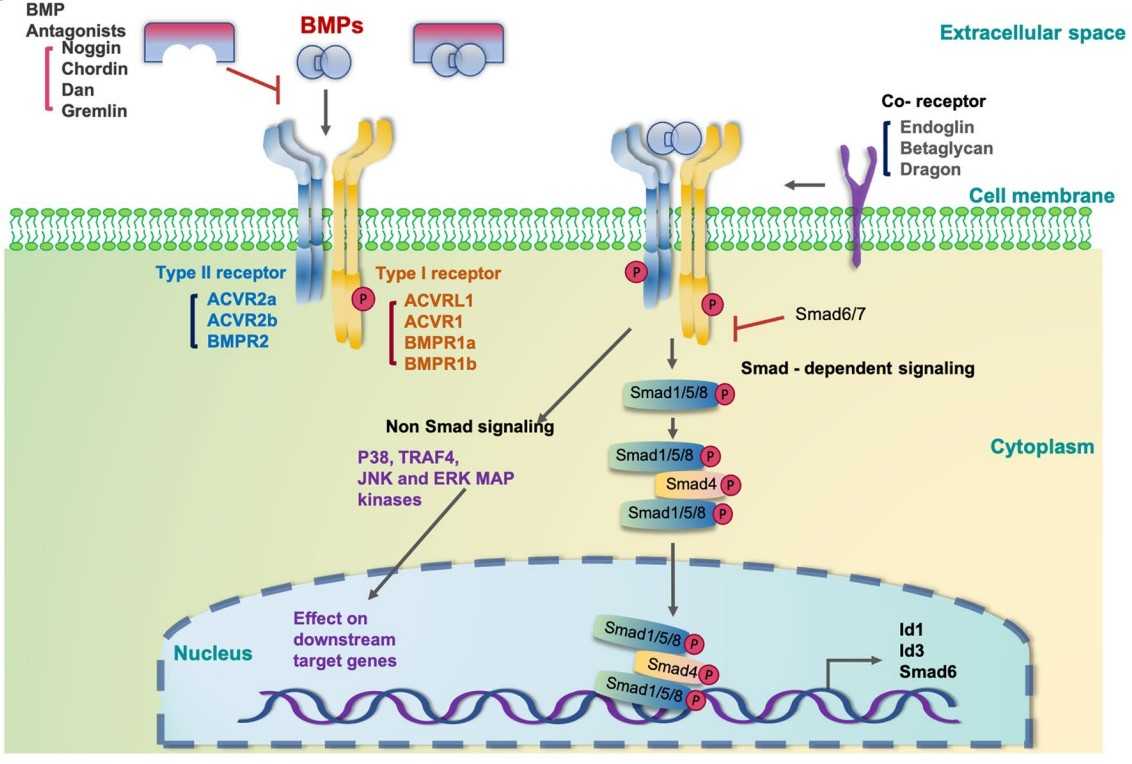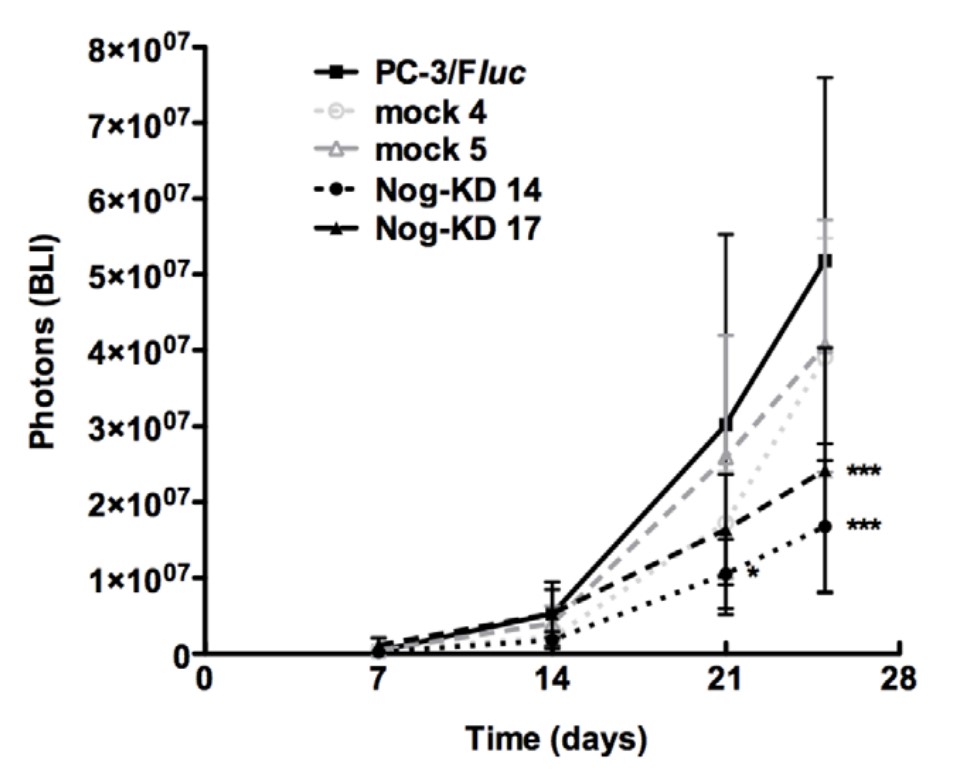NOG
-
Official Full Name
noggin -
Overview
The secreted polypeptide, encoded by this gene, binds and inactivates members of the transforming growth factor-beta (TGF-beta) superfamily signaling proteins, such as bone morphogenetic protein-4 (BMP4). By diffusing through extracellular matrices more efficiently than members of the TGF-beta superfamily, this protein may have a principal role in creating morphogenic gradients. The protein appears to have pleiotropic effect, both early in development as well as in later stages. It was originally isolated from Xenopus based on its ability to restore normal dorsal-ventral body axis in embryos that had been artificially ventralized by UV treatment. The results of the mouse knockout of the ortholog suggest that it is involved in numerous developmental processes, such as neural tube fusion and joint formation. Recently, several dominant human NOG mutations in unrelated families with proximal symphalangism (SYM1) and multiple synostoses syndrome (SYNS1) were identified; both SYM1 and SYNS1 have multiple joint fusion as their principal feature, and map to the same region (17q22) as this gene. All of these mutations altered evolutionarily conserved amino acid residues. The amino acid sequence of this human gene is highly homologous to that of Xenopus, rat and mouse. -
Synonyms
NOG;noggin;SYM1;SYNS1
Recombinant Proteins
- Human
- Mouse
- Rhesus macaque
- Chicken
- Rat
- Mouse/Rat
- Human
- Dog
- Pig
- E.coli
- HEK293
- Nicotiana Benthamiana
- CHO
- Mammalian Cells
- Human Cells
- NS0
- Insect Cell
- In Vitro Cell Free System
- His
- Fc
- Avi
- Non
- MBP
- GST
- Myc
Background
What is NOG protein?
NOG (noggin) gene is a protein coding gene which situated on the long arm of chromosome 17 at locus 17q22. The protein appears to have pleiotropic effect, both early in development as well as in later stages. It was originally isolated from Xenopus based on its ability to restore normal dorsal-ventral body axis in embryos that had been artificially ventralized by UV treatment. The results of the mouse knockout of the ortholog suggest that it is involved in numerous developmental processes, such as neural tube fusion and joint formation. The NOG protein is consisted of 232 amino acids and its molecular mass is approximately 25.8 kDa.
What is the function of NOG protein?
NOG is an antagonist of bone morphogenetic proteins (BMPs), which are part of the transforming growth factor-beta (TGF-β) superfamily. The primary function of NOG protein is to bind and inactivate BMPs, thereby modulating the BMP signaling pathway. In the context of bone and cartilage formation, NOG protein plays a significant role. It can effectively attenuate osteoarthritis (OA) by protecting cartilage and preventing its degradation, as indicated by research that demonstrates the therapeutic potential of NOG protein in treating OA. Furthermore, NOG protein is involved in numerous developmental processes such as neural tube fusion and joint formation. In addition to its role in development and bone metabolism, NOG protein is also used in the field of organoid culture. It is added to the culture medium to coordinate Wnt signal activation in stem cells, promoting their proliferation.
NOG Related Signaling Pathway
NOG can bind and inhibit the binding of Wnt protein to LRP5/6 receptor, thereby preventing Wnt protein from entering the cell and further inhibiting the activation of β-catenin, thereby inhibiting the Wnt/β-catenin signaling pathway. NOG can bind and inhibit the binding of BMP protein to its receptor, thereby preventing BMP protein from entering the cell and further inhibiting the activation of Smad protein. NOG can bind and activate the FGF receptor, thereby further activating the FGF signaling pathway and promoting cell proliferation and differentiation. NOG can bind and activate TGF-β receptors, thereby further activating the TGF-β signaling pathway and promoting cell proliferation and differentiation.

Fig1. BMP signalling. (Bo Kyoung Kang, 2023)
NOG Related Diseases
NOG plays an important role in nervous system development, and its abnormal expression is associated with neural tube defects, hydrocephalus, autism and other neurological developmental disorders. NOG is also involved in the regulation of bone development, and its abnormal expression is associated with spina bifida, polydactyly, osteoporosis and other skeletal abnormalities. The abnormal expression of NOG is associated with the occurrence and development of various tumors, such as breast cancer, gastric cancer, and lung cancer. NOG is also associated with the occurrence and development of some other diseases, such as cardiovascular disease, diabetes, liver disease, etc.
Bioapplications of NOG
Tetrahydropyrimidine (Ectoine) is a cyclic amino acid derived from L-aspartic acid that acts as a protective and stabilizing agent and plays an important role in cells in response to various external pressures, such as high temperature, high osmotic pressure, drying, and radiation. NOG protein has made important progress in the efficient preparation of tetrahydropyrimidine, and through the strategy of combining metabolic engineering and enzyme engineering, it has achieved efficient synthesis in Escherichia coli.
Due to the protective and stabilizing effects of tetrahydropyrimidine, NOG proteins also have applications in the cosmetic industry, especially in the development of products that protect the skin from environmental stress.
Studies have shown that NOG proteins can effectively reduce the condition of osteoarthritis (OA) by protecting the cartilage and preventing its degeneration, which indicates that NOG proteins have potential applications in the treatment of cartilage degenerative diseases such as OA.
Case Study
Case Study 1: Karolina Truchan, 2024
The balance between Noggin and bone morphogenetic proteins (BMPs) is important during early development and skeletal regenerative therapies. Noggin binds BMPs in the extracellular space, thereby preventing BMP signaling. However, Noggin may affect cell response not necessarily through the modulation of BMP signaling, raising the possibility of direct Noggin signaling through yet unspecified receptors. Here we show that in osteogenic cultures of adipose-derived stem cells (ASCs), Noggin activates fibroblast growth factor receptors (FGFRs), Src/Akt and ERK kinases, and it stabilizes TAZ proteins in the presence of dexamethasone. Overall, this leads ASCs to increased expression of osteogenic markers and robust mineral deposition. The results also indicate that Noggin can induce osteogenic genes expression in normal human bone marrow stem cells and alkaline phosphatase activity in normal human dental pulp stem cells. Besides, Noggin can specifically activate FGFR2 in osteosarcoma cells.
 activity.jpg)
Fig1. Alkaline phosphatase (ALP) activity after 7-d culture of normal human bone marrow stromal cells.
.jpg)
Fig2. Phosphorylation of FGFR Type 2 (p-FGFR2) after 1-h Noggin stimulation of SaOS-2 cells, that are abundant in FGFRs.
Case Study 2: Chiara Secondini, 2011
Members of the BMP and Wnt protein families play a relevant role in physiologic and pathologic bone turnover. Extracellular antagonists are crucial for the modulation of their activity. Lack of expression of the BMP antagonist noggin by osteoinductive, carcinoma-derived cell lines is a determinant of the osteoblast response induced by their bone metastases. In contrast, osteolytic, carcinoma-derived cell lines express noggin constitutively. Intra-osseous xenografts of PC-3 prostate cancer cells induced osteolytic lesions characterized not only by enhanced osteoclast-mediated bone resorption, but also by decreased osteoblast-mediated bone formation. Bone formation was preserved in the osteolytic lesions induced by noggin-silenced PC-3 cells, suggesting that cancer cell-derived noggin interferes with physiologic bone coupling. Furthermore, intra-osseous tumor growth of noggin-silenced PC-3 cells was limited, most probably as a result of the persisting osteoblast activity. This investigation provides new evidence for a model of osteolytic bone metastasis where constitutive secretion of noggin by cancer cells mediates inhibition of bone formation, thereby preventing repair of osteolytic lesions generated by an excess of osteoclast-mediated bone resorption.
.jpg)
Fig3. Noggin protein secreted in the conditioned medium (CM) from PC-3/Fluc, mock and Nog-KD clones.

Fig4. Noggin silencing limits growth of PC-3/Fluc cells in bone xenografts.
Quality Guarantee
Involved Pathway
NOG involved in several pathways and played different roles in them. We selected most pathways NOG participated on our site, such as BMP receptor signaling,BMP signalling and regulation,Cardiac Progenitor Differentiation, which may be useful for your reference. Also, other proteins which involved in the same pathway with NOG were listed below. Creative BioMart supplied nearly all the proteins listed, you can search them on our site.
| Pathway Name | Pathway Related Protein |
|---|---|
| Signal Transduction | CUL5A,USP2,NMBB,PTPRK,PROKR2,GDI2,RBCK1,KREMEN1,FABP11B,CRABP1B |
| Cardiac Progenitor Differentiation | NKX2,LIN28A,ROR2,SOX1,IRX4,LIN28B,SIRPA,T,TBX5,NIPAL1 |
| BMP signalling and regulation | TOB1 |
| Signaling by BMP | FSTL1,SKIA,SKIB,NOG1,FSTL1A,CALML4,GREM2,CHRDL1,FSTL1B |
| BMP receptor signaling | GREM1,HFE2,CTDSPL,CTDSP2,RGMA,RGMB,FST,CALML4,CTDSP1,AHSG |
| TGF-beta signaling pathway | BMP8A,BMPR1AA,E2F5,GDF6A,LFT1,ACVR2B,BAMBI,AMHR2,TGFB1,PPP2CA |
| TGF Beta Signaling Pathway | ZNF423,RUNX3,TGFBR3,FOXH1,ZFP423,ENG,LEFTY1,FST |
Protein Function
NOG has several biochemical functions, for example, cytokine binding,protein binding,protein complex binding. Some of the functions are cooperated with other proteins, some of the functions could acted by NOG itself. We selected most functions NOG had, and list some proteins which have the same functions with NOG. You can find most of the proteins on our site.
| Function | Related Protein |
|---|---|
| protein complex binding | RAD18,GNB2,TRAF2,MLKL,MTHFR,PROS1,ABP1,CASP8,UQCRC1,ERCC6 |
| protein homodimerization activity | NR6A1,Trl,ZFP365,TFAP4,HOGA1,HNF1B,ADRB2,ATIC,CAMK2D,TMEM173 |
| protein binding | ABCD1,Icosl,EDC4,SRSF10,ZBTB7C,TLX3,FOXO3,CPNE3,KLRK1,C1orf51 |
| cytokine binding | LIFR,Fzd4,CRLF1,CHRD,NRP2,IFNGR1,GBP1,KITB,CSF1RA,PARK7 |
Interacting Protein
NOG has direct interactions with proteins and molecules. Those interactions were detected by several methods such as yeast two hybrid, co-IP, pull-down and so on. We selected proteins and molecules interacted with NOG here. Most of them are supplied by our site. Hope this information will be useful for your research of NOG.
BMP2;BMP7;GDF5
Resources
Research Area
Related Services
Related Products
References
- Ohshima, S; Mori, S; et al. Differentiation ability of multipotent hematopoietic stem/progenitor cells detected by a porcine specific anti-CD117 monoclonal antibody. BIOSCIENCE TRENDS 8:308-315(2014).
- Ishikawa, Y; Usui, T; et al. Functional engraftment of human peripheral T and B cells and sustained production of autoantibodies in NOD/LtSzscid/IL-2R gamma(-/-) mice. EUROPEAN JOURNAL OF IMMUNOLOGY 44:3453-3463(2014).


.jpg)
.jpg)

